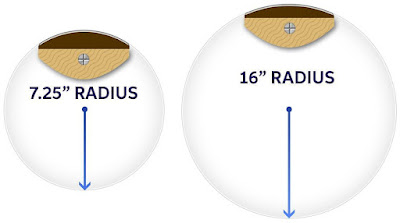Radiused vs. Non-radiused
In the world of string instrument fingerboards, there are two basic types: radiused and non-radiused. Radius in this instance refers to the arch of the top of the fingerboard. Bowed instruments have rather severe radii so that each string can be individually bowed without the bow touching adjacent strings. Guitars aren't usually bowed, so the radius of guitar fingerboards isn't as extreme as those in the violin family. Violins can have something like a 1.6 inch radius, whereas most acoustic guitars average around 16 to 20 inches. Electric guitars are around seven inches. And there's the matter of compound radii, but that's another topic for another blog post.
Classical guitars are an entirely other matter. Classical guitars have a non-radiused, or flat, fingerboard. There are various reasons for this. Classical guitar fingerboards are flat to facilitate precise finger placement and easier access to strings for complex fingerstyle (in the right hand) playing. This design aids in playing intricate classical music pieces.
Classical guitars differ significantly from their steel-string counterparts. One of the distinctive features is the flat fingerboard, a design that caters to the demands of classical guitar techniques. Technical facility for the guitarist during complex passages and extended pieces are paramount, and the flat fingerboard enhances these aspects. That is, in the world of nylon strings and classical right-hand technique.
A non-radiused fingerboard supports subtle nuances that the flat surface provides, including better finger contact with the strings and improved control over nuances like vibrato and microtonal slides.
Or so goes the writ of ancient classical guitar wisdom. I'm not convinced that this reasoning is all entirely true or accurate.
Additionally, there's currently a pretty strict, yet tacit, demarcation stating that only nylon-string (classical) guitars have non-radiused fingerboards, and only steel-string guitars have radiused fingerboards. I don't subscribe to this demarcation.
My steel-string instruments have both radiused and non-radiused fingerboards. As specific as I am with virtually every detail and facet of my instruments, when it comes to the actual measurement of the radius of a radiused fingerboard, I don't have a strict preference. That's because on my instruments, the necks are so wide that there's not a single radius measurement that would work on each one; ergo, they all have differing radii, based on the fingerboard width.
I have both nylon and steel-string instruments with non-radiused fingerboards. There was a time wherein I didn't have a preference for radiused or non-radiused, as both have their pros and cons.
In fact, on the 36-string Double Contraguitar, one neck has a radiused fingerboard, and the other has a non-radiused fingerboard. On the 30-string Contra-Alto guitar, the contra neck's fingerboard is non-radiused; while the alto fingerboard is indeed radiused.
A non-radiused fingerboard on a steel-string instrument forces me to play differently. Not better or worse; just differently. I'd almost state that you can't play exactly the same on both types of fingerboards, but that's not entirely true. I do enjoy playing on both types.
However, of late, I think I am developing a stronger preference for radiused fingerboards as my technique evolves. I find that radiused fingerboards, for me, are more welcoming for techniques such as tapping, two-handed techniques, legato techniques, and more. It's not that those techniques are impossible on a non-radiused fingerboard; they're just harder to execute, and these techniques don't speak as well on non-radiused fingerboards. Additionally, in my case anyway, I find radiused fingerboards to be more responsive to subtle details in playing and techniques.
It's been an interesting discovery, and being able to verbalize it is helpful. For a couple of years, I felt like something was wrong when playing non-radiused fingerboards. Now that I've had enough time to analyze and define what I thought was wrong, it's not wrong at all. It's just less of an exact fit for me.
-kk




Comments
Post a Comment